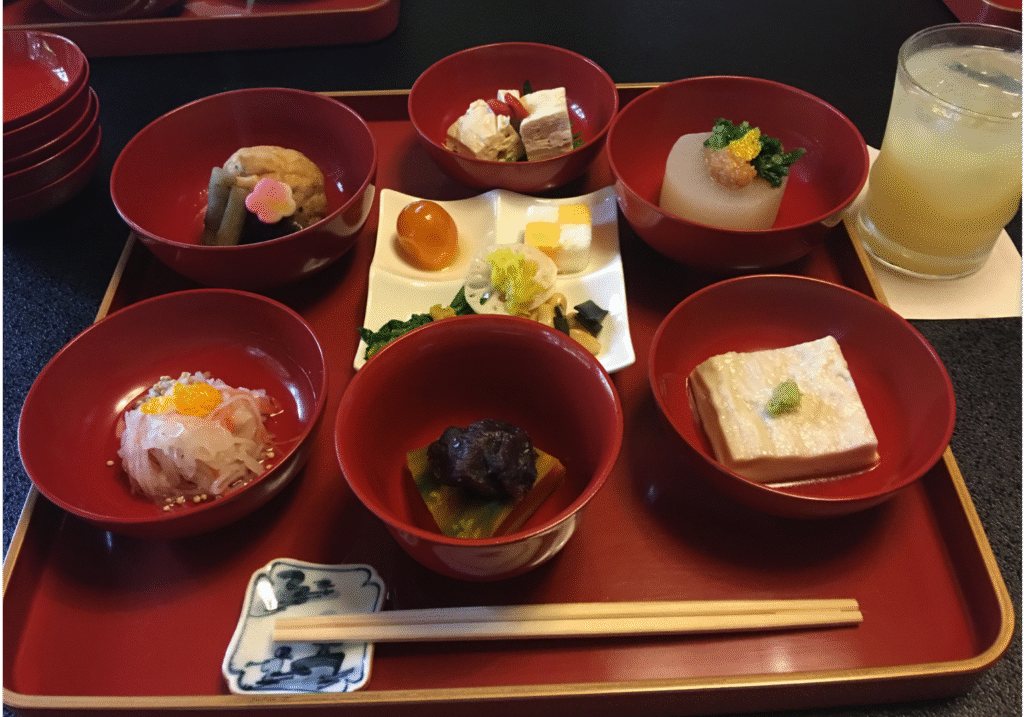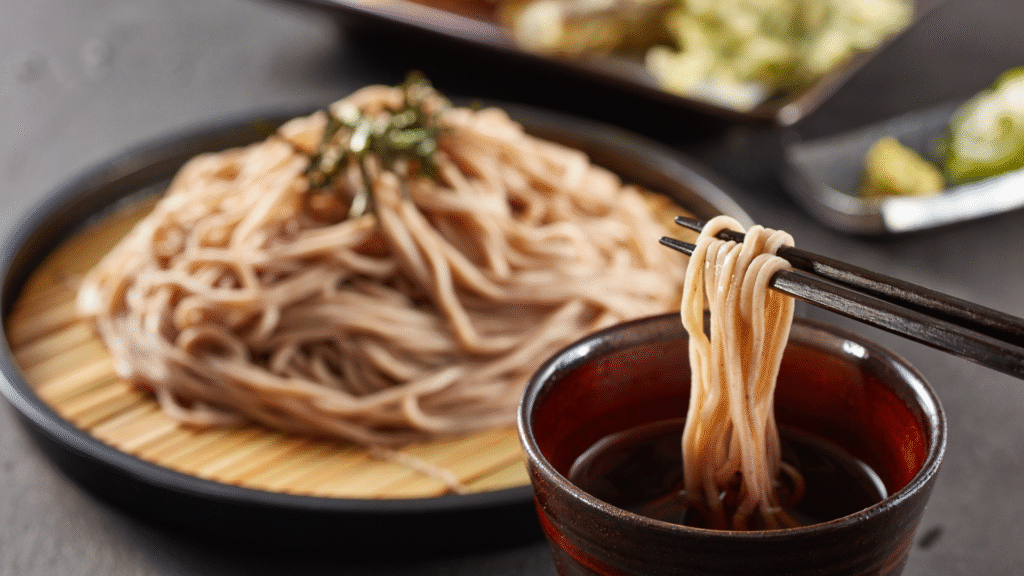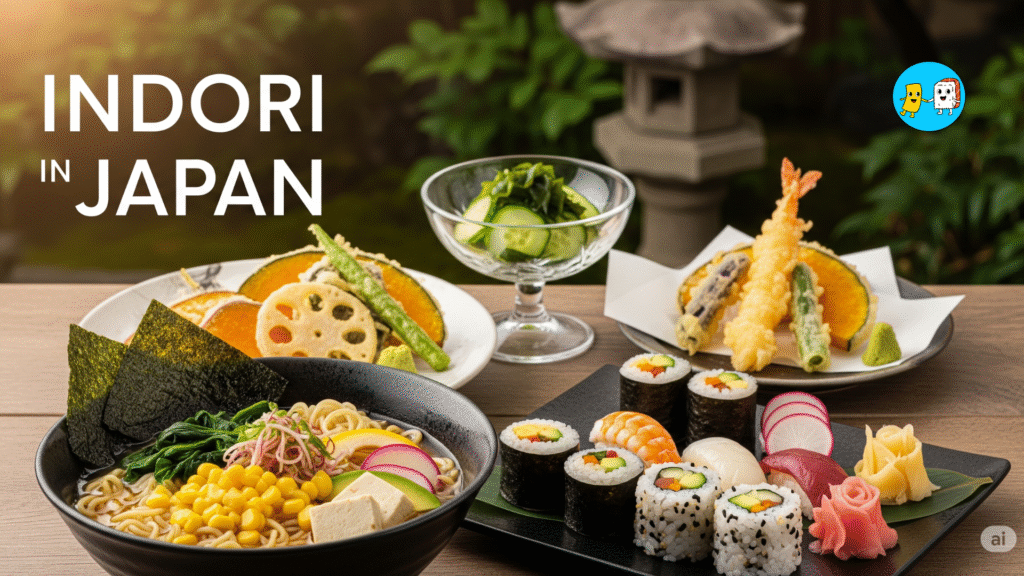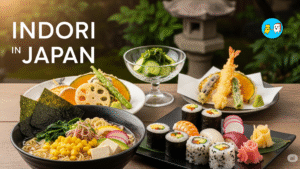Eating Vegan in Japan 🥗: A Guide to Japanese Vegan Cuisine & Dashi
Konnichiwa, Fellow Food Explorers! My Vegetarian Quest in Japan Begins!
Hey everyone, Akash here, your friendly Indori in Japan! You know, when I first landed in this amazing country, my mind was buzzing with visions of ramen, sushi, and all those iconic Japanese dishes. I, for one, have been able to enjoy all the incredible flavours this country has to offer, but a thought hit me as I watched my vegetarian friends navigate the same culinary landscape: “This is a whole new challenge for them!” It felt like they were embarking on a completely different adventure, not just in Japan, but on their plates too!
Well, after countless meals, a few ‘oops’ moments, and a lot of delightful discoveries, I’m here to tell you: being vegetarian in Japan is not just possible, it’s becoming easier and more delicious than ever! This isn’t just a list; it’s my personal playbook, packed with everything I’ve learned to help you navigate Japan’s incredible culinary landscape without a single worry about what’s on your plate. From hidden gems to popular chains, and even how to chat with restaurant staff, consider this your ultimate green map! For more of my adventures, including my courses, books, and other blogs.
Before we dive deep, let me give you a little heads-up, a gentle whisper about a ubiquitous ingredient that often sneaks into dishes: dashi. It’s the backbone of Japanese cuisine, but for us vegetarians, it’s often the first hurdle. Don’t worry, we’ll tackle this head-on, but it’s crucial to be aware from the get-go. Our guide to Japanese vegan cuisines helps you find delicious plant-based options, from dedicated restaurants to chain eateries, so you can enjoy every meal.
Decoding the Japanese Menu: What "Vegetarian" Really Means Here
Navigating the Japanese culinary scene as a vegetarian requires understanding a few key concepts, particularly regarding ingredients that might not be immediately obvious. The very foundation of many Japanese dishes, dashi, presents the primary challenge. This savoury stock is pervasive throughout Japanese cooking, providing the characteristic umami flavour that defines the cuisine. While dashi commonly utilises kombu (kelp seaweed), it is most often combined with katsuobushi (dried bonito flakes) or niboshi (small dried fish). This means that seemingly simple dishes, such as miso soup, are almost always made with fish stock unless explicitly stated otherwise. Similarly, traditional ramen broths frequently incorporate dashi, making them unsuitable for vegetarians.6 This widespread use of fish-based dashi highlights a significant cultural difference in what “vegetarian” implies. Many Japanese people may not instinctively associate fish or fish derivatives like dashi or bonito flakes with “meat,” leading to misunderstandings when a diner simply states they are “vegetarian”. A dish might be presented as vegetarian because it lacks overt pieces of meat, yet its underlying broth or seasoning still contains animal products. This necessitates a more proactive and precise approach from the diner, moving beyond a simple “Is it vegetarian?” to specifically inquiring about dashi and other hidden ingredients.
Beyond dashi, several other stealthy ingredients can appear in Japanese cuisine. Katsuobushi, or bonito flakes, are a common garnish that you might find sprinkled on dishes like okonomiyaki, hiyayakko (cold tofu), agedashi-dofu (deep-fried tofu), and even salads. Consomme, a soup stock made from ground meat, is frequently used in Japanese-Western fusion dishes, serving as the base for clear soups in many family restaurants. In coastal regions, shirasu, small white fish, are often served as toppings on rice dishes. Furthermore, most Japanese curry roux is made using animal fat or extracts, meaning even a vegetable curry might contain meat derivatives or hidden chunks. Even seemingly innocuous items like mochi can be problematic, as savoury versions are sometimes flavoured with shellfish, and sweet mochi might contain dairy or honey fillings. Yakisoba sauce, a popular flavouring for stir-fried noodles, often includes oyster sauce. These ingredients, often used for flavour enhancement or texture, are not always immediately obvious, making it challenging for vegetarians who rely solely on visual inspection or simple “no meat” requests. This complexity underscores the importance of thorough research and specific communication to ensure a truly plant-based meal.
The definition of “vegetarian” also carries nuances regarding eggs and dairy. While many vegetarians consume these products, stricter diets (veganism) do not. In Japan, the term “vegetarian” might loosely encompass dishes with eggs (e.g., Tamago sushi, Omurice, Chawanmushi). Even in shojin ryori, traditional Buddhist cuisine known for its strict plant-based principles, modern monks might occasionally use dairy, as it is not considered harmful to animals. For instance, while Mos Burger’s Green Burger is fully vegan, some of their other soy patty burgers contain dairy in the bun. Japanese Oreos, unlike their counterparts in many other countries, contain milk powder, rendering them non-vegan. Starbucks, an international chain, does offer plant-based milk options like oat and soy milk, but it’s worth noting that their almond milk is not vegan.
Another important consideration is cross-contamination. Even if a dish’s ingredients are plant-based, the cooking method can introduce animal products. For example, vegetable tempura might be fried in the same oil as seafood. Similarly, a “mochi cheese” dish at an ayakitori place, while appearing vegetarian, might have been cooked in meat stock. This spectrum of “vegetarian-friendliness” in Japan means that a dining experience can range from fully compliant at dedicated vegan restaurants to requiring careful navigation and compromise, such as accepting shared frying oil. Travellers must understand their own level of dietary strictness and align it with the restaurant’s capabilities. The rise of dedicated vegan and vegetarian establishments, alongside increasing awareness in chain restaurants, indicates a positive trend towards greater accommodation. However, the traditional understanding of ingredients still prevails in many smaller or older establishments, making informed choices paramount.
Your Green Map: Dedicated Vegetarian & Vegan Restaurants
For those seeking guaranteed plant-based meals without the guesswork, Japan’s growing number of dedicated vegetarian and vegan restaurants is a true blessing. A fantastic starting point for finding these establishments is Happy Cow, an excellent online resource for fully vegetarian or vegan restaurants worldwide.
In Tokyo, several plant-based gems stand out.
- T’s Tantan: A renowned vegan ramen chain with multiple branches, including convenient locations in Ueno Station, Tokyo Station, Narita Airport, and Jiyugaoka. It’s celebrated for its authentic-tasting ramen, even featuring a convincing fake chashu pork.
- Offerings: Tantan noodles, shoyu (soy sauce) ramen, Pho with Vegetables & Veggie Karaage, Eight Vegetable & Bean Kaphrao Plate, Gyoza.
- Website: T’s Tantan official website
- Kyushu Jangara: A cosy ramen spot that offers a vegetarian option with fake chashu pork and has branches in popular areas like Harajuku, Ginza, Akihabara, and Asakusa.
- Soranoiro: A ramen shop found in Tokyo Station’s Ramen Street and Hirakawacho, though it’s known for closing once its soup runs out.
- Udatsu Sushi: A Michelin-starred restaurant, offers an exquisite 18-course vegetarian omakase sushi course crafted with fresh, seasonal ingredients, emphasising “art x sushi”.
- Website: Omakase sushi (Vegan)
- Nouka no Daidokoro Shinjuku Sanchome: A farm-to-table buffet-style restaurant featuring an extensive salad bar, vegetable fritters, and soy meat hamburg steak.
- Eat More Greens: In Azabujuban near Roppongi, noted for its vegetarian tomato sauce.
- Other notable vegan and vegetarian restaurants in Tokyo: Bon, Vegan Gyoza Yu, Polyphony, Pizza Marumo, Vegan Ramen UZU Tokyo, and Vegan Place Shuwashuwa Peace.
The consistent recommendation of resources like Happy Cow highlights a crucial aspect of vegetarian dining in Japan: relying on technology. Unlike some countries where simply walking into a restaurant might yield safe options, the prevalence of hidden ingredients in Japan makes pre-screening vital. Platforms like Happy Cow and online directories, such as byFood’s list of vegetarian-friendly restaurants, act as essential bridges, connecting informed diners with accommodating establishments. This technological assistance mitigates the language barrier and the cultural understanding gap, enabling more confident and enjoyable dining experiences. The increasing availability and reliability of such platforms reflect a growing demand for and supply of vegetarian options, indicating a positive shift in Japan’s culinary landscape, influenced by both international tourism and evolving local preferences. While Tokyo leads the way in dedicated plant-based eateries, the growing interest in wellness and sustainability means that vegetarian options, particularly traditional Shojin Ryori, are becoming more accessible in other regions, especially near temples or in health-conscious urban centres.
Chain Reaction: Vegetarian-Friendly Fast Food & Family Restaurants
For quick, reliable, and widely available vegetarian options across Japan, chain restaurants and family diners are increasingly becoming your best friends. These establishments offer consistent menus and are often found in various cities and towns, providing a predictable and often affordable solution, especially when dedicated vegan restaurants are scarce.
- Mos Burger: A standout, offering its “Green Burger,” a fully vegan option featuring a plant-based patty, a spinach-infused bun, and vegan teriyaki mayonnaise. They also provide a selection of soy patty burgers, though it’s important to note that the buns for these contain dairy, so they are not entirely vegan. With branches throughout Japan, Mos Burger is a dependable choice for a satisfying vegetarian meal.
- Website: Mos Burger official site
- Coco Ichibanya: A fast-food curry chain with numerous locations. They offer a fully vegetarian curry sauce at every branch, which is a game-changer. You can customise your curry by choosing a spice level, adjusting the amount of rice and sauce, and adding various vegetables, cheese, or egg toppings. This chain’s widespread presence and customizable options make it an invaluable resource for a hearty, plant-based meal.
- Offerings: CoCoICHI vegetarian curry, CoCoICHI vegetarian curry with soy meat hamburger, CoCoICHI vegetarian curry with vegetables.
- Website: Coco Ichibanya Menu
- Hanamaru Udon: An udon and tempura chain identifiable by its orange sign, offers the Oroshi Shoyu Udon (udon with grated radish and soy sauce) as a vegetarian choice. However, it is crucial to avoid any dishes that come with soup, as it almost certainly contain fish stock.4 They also provide vegetable tempura items and sides like Inari nigiri (tofu sushi), plain rice, and boiled eggs.
“Family restaurants” like Teishoku Yayoi (Yayoiken) and Ootoya offer a more traditional Japanese dining experience with set meals.
- Teishoku Yayoi: Has introduced soy meat dishes, including a stir-fried soy meat and vegetable set meal, a ginger soy meat set, and a natto breakfast set, along with other side dishes.4 Be aware that their miso soup, like most non-vegetarian restaurants, likely contains fish stock.
- Ootoya: While not having specific vegetarian set meals, allows diners to create their own from a selection of side dishes such as tofu, natto, egg, grated yam, pumpkin korroke, spinach in sesame sauce, shredded cabbage salad, and various vegetable bowls.
Even international chains provide unexpected vegetarian allies.
- IKEA: Offers vegan katsu curry (though not at Shibuya or Harajuku branches), veggie cheese dogs (only at Harajuku), a plant-based kebab wrap (Harajuku only), dairy-free soft serve ice cream, and vegan instant cup ramen to take away.
- Starbucks: A reliable spot for plant-based beverages and snacks, with vegan options like sugar-glazed doughnuts, banana rice flour muffins, tiramisu, spinach corn & soy patty English muffins, and keema curry filone, along with oat and soy milk options for drinks.
Other notable chains expanding their vegetarian offerings include:
- Royal Host: Provides a fully vegetarian vegetable curry and mixed grain rice.
- Freshness Burger: Primarily offers soy-based burgers.
- Torikizoku (yakitori place): Has vegetarian small plates such as potato salad (ask for it without katsuobushi), “endless” cabbage salad, tomato, edamame, and chips, though caution is advised as some items like mochi cheese might be cooked in meat stock.
- On-Yasai (shabu shabu restaurant): Allows you to choose konbu dashi (seaweed stock) for your hotpot broth, offering a box of vegetables, tofu, and mochi.
- Several sushi chains like Uobei, Himawari, and Katsumidori also provide veggie options such as avocado rolls and kappa maki.
- Tendon Tenya Tempura: Features a vegetable tempura bowl on its menu.
- Website: Tendon Tenya Tempura
The widespread adoption of vegetarian options by these large chains signals a significant shift in the Japanese food industry, responding to both international demand and growing domestic health and ethical consciousness. This trend is a positive indicator for the future of vegetarian dining in Japan, making it more accessible and less stressful for plant-based travellers and residents alike.
Shojin Ryori: A Culinary & Spiritual Journey
-
- Vegetable tempura (traditionally made with an egg-free batter).
- Goma tofu (a sesame seed “tofu” that surprisingly doesn’t use actual tofu).
- Shiraae (a mashed tofu and vegetable salad flavoured with sesame and soy sauce).
- Kenchinjiru (a hearty soup of dashi, tofu, konnyaku, and various vegetables, though check for meat in non-shojin ryori versions).
- Pickled vegetables and rice.
- Modern Shojin Ryori has also evolved to incorporate ingredients not traditionally used, such as tomato, cauliflower, and basil, reflecting contemporary health consciousness.
- This cuisine is primarily found in temple restaurants, but its popularity among vegetarians and those seeking healthier options has led to its increasing availability in cities.
- Notable restaurants: Daigo in Tokyo (Michelin-starred), Sougo in Roppongi, Tenryuji Temple Shigetsu in Kyoto.
- It’s important to note that while historically Shojin Ryori is vegan and even omits pungent flavours like garlic and onion, some modern monks might occasionally use dairy, as it’s not considered harmful to animals.

| Principal/Dish | Description |
|---|---|
| Core Principles | Plant-Based (no meat/fish), Non-Killing, Respect for Ingredients, Mottainai (anti-waste), Seasonality, Rule of Five (colours: white, green, yellow, black, red; flavours; cooking methods), Ichiju-Sansai (one soup, three dishes) |
| Common Dishes | Vegetable Tempura (traditionally egg-free), Goma Tofu (sesame seed 'tofu'), Shiraae (mashed tofu/veg salad), Nimono (simmered vegetables) |
| Where to Find | Temple restaurants, dedicated city restaurants (e.g., Daigo in Tokyo) |
Tofu Takes Centre Stage
-
- Dengaku-dofu: Grilled tofu slices topped with a salty, creamy miso paste. While generally vegetarian, it’s wise to confirm the miso paste doesn’t contain additional non-vegetarian condiments.
- Hiyayakko: A cold silken tofu dish, common in Izakaya restaurants, typically served with grated ginger and/or sliced cucumbers and soy sauce; however, some places may add katsuobushi (fish flakes) on top, so always check.
- Agedashi-dofu: Deep-fried tofu served in a broth, but its broth may also contain katsuobushi.
- Kyoto is particularly famous for its tofu specialities, including yudofu (simmered tofu) and elaborate tofu kaiseki (multi-course meals).
- Yuba, or tofu skin, is another soy-based delicacy popular in areas like Nikko
- Teriyaki Tofu.
Onigiri: Your Portable Power-Up
Onigiri, the ubiquitous ready-made rice balls wrapped in seaweed, are an absolute staple for vegetarians in Japan, especially when you’re on the go. Convenience stores (konbini) consistently stock a variety of traditional vegetarian options, making them a reliable source for quick, satisfying snacks or light meals.
- Common vegetarian fillings:
- Ume (pickled plum).
- Konbu (seaweed).
- Takana (mustard leaves).
- Sekihan (red azuki bean, slightly sweet and salty).
- Gomashio (salt and sesame).
- Natto (fermented soybeans).
- Inari (sweetish-filled tofu pouches).
- Kappa (cucumber).
- Oshinko (pickled radish).
For those looking for more inventive plant-based options, onigiri can also be made with fillings like edamame, teriyaki tofu, or even a chickpea “tuna”.
- Recipes: Vegetable Onigiri Balls
Yaki Onigiri, grilled rice balls with a crispy crust and soy sauce glaze, are also a delicious vegetarian option.
- Recipes: Yaki Onigiri
The consistent availability and variety of onigiri make convenience stores a highly accessible source of vegetarian food, particularly when traditional restaurants might be closed or difficult to navigate. This empowers vegetarians to be self-sufficient and significantly enhances the ease of travel or living in Japan.
| Filling (English) | Japanese Name/Kanji |
|---|---|
| Pickled Plum | 梅 (Ume) |
| Seaweed (Kombu) | 昆布 (Konbu) |
| Mustard Leaves | 高菜 (Takana) |
| Red Azuki Bean | 赤飯 (Sekihan) |
| Salt & Sesame | 胡麻塩 (Gomashio) |
| Fermented Soybeans | 納豆 (Natto) |
| Sweet Tofu Pouch | いなり (Inari) |
| Cucumber | かっぱ (Kappa) |
| Pickled Radish | お新香 (Oshinko) |
Sushi Sensations
While sushi is often synonymous with fish, a vibrant world of vegetarian sushi exists in Japan. Many sushi options are naturally vegetarian.
Vegetarian sushi options:
- Kappa-maki (cucumber rolls).
- Oshinko-maki (pickled radish rolls).
- Ume-jiso-maki (sour plum and perilla leaf).
- Natto-maki (fermented soybeans).
- Tamago (sweet omelette).
- Kanpyo-maki (dried pumpkin).
- Inari (sweetish-filled tofu pouches).
For a truly elevated experience, Udatsu Sushi, a Michelin-starred establishment, even offers an elaborate 18-course vegetarian omakase sushi menu.
Tempura Tips & Tricks
Vegetable tempura, consisting of lightly battered and deep-fried vegetables, is a popular and satisfying dish.
- Common vegetables used: sweet potato, eggplant, green beans, kabocha (pumpkin), shiitake mushrooms, king oysters, lotus roots, bell peppers, shiso leaves, kale, zucchini, and onions.
- When ordering, you can specifically ask for “yasai dake” (vegetables only) to ensure no seafood is included.
- However, it is crucial to inquire if the batter contains eggs and if the vegetables are fried in the same oil as seafood, as cross-contamination can occur.
- The accompanying tentsuyu (dipping sauce) typically contains dashi, so a safer alternative is to use plain soy sauce.
- Recipes: Vegetable Tempura
Many traditional dishes like tempura can be made vegetarian, but they often require specific requests, highlighting the importance of clear communication with restaurant staff.
Noodle Nirvana (with Caution)
Noodle dishes like ramen, udon, and soba are Japanese staples, but the broth is often the main challenge for vegetarians, as most traditionally use animal-based dashi.
- For a safer bet, Zaru Soba (cold buckwheat noodles) is served with a dipping sauce that can be avoided in favour of plain soy sauce, as the traditional dipping sauce usually contains fish dashi.
- Recipes: Cold Soba Noodles
- If you’re set on hot noodles, options like Kake soba/udon (simple noodles with spring onions), Tempura soba/udon, Kitsune soba/udon (with deep-fried tofu strips), Sansai soba/udon (with wild ferns), and Tsukimi soba/udon (with a raw egg) can be considered if the broth is explicitly confirmed to be plant-based or if you are willing to exclude the soup.
- Fortunately, vegetarian ramen recipes exist, and vegan dashi can be used to prepare delicious vegetarian udon.

Okonomiyaki Adventures
Okonomiyaki, often described as Japanese pancakes, typically features cabbage and spring onions but often includes various chunks of meat or seafood.
- The good news is that you can often ask for it without meat or seafood, and to omit katsuobushi (fish flakes) from the topping.
- Some restaurants are particularly vegetarian-friendly; for instance, Sakuratei offers guaranteed vegetarian batter, and places like Zen Shinjuku and Bassa Nova even provide separate vegan menus.
- Okonomiyaki can be made with or without eggs and, upon request, with plant-based dashi. Teppan Baby is another spot that allows for customisation.
- For those who enjoy cooking, it’s also relatively easy to make okonomiyaki at home using vegan sauces and mayonnaise.
- Recipes: Vegan Okonomiyaki
This makes okonomiyaki a fun, customizable dish that can be enjoyed by vegetarians, especially at establishments willing to adapt.
Mastering the Language: Your Communication Toolkit
Navigating dietary restrictions in Japan can be significantly smoother with a few key Japanese phrases and strategies. While English is becoming more common, especially in major tourist areas, having the right words can make a world of difference in ensuring your dietary needs are understood and respected.
It is important to understand that a direct translation of “vegetarian” may not fully convey your dietary scope in Japan, particularly regarding fish and dashi. Many Japanese individuals may not consider fish to be “meat” in the same category as beef or pork, and fish-based dashi is such a fundamental part of their cuisine that its animal origin may not be immediately obvious to them. Therefore, learning specific phrases that clearly state “no meat,” “no fish,” and “no animal broth” is critical for effective communication. Sometimes, stating that you have an “allergy” can also be met with more seriousness and prompt greater caution from staff. This precise communication empowers you to be explicit and increases the likelihood of a safe and enjoyable meal.
Here are some essential Japanese phrases to help you communicate your dietary needs:
| English Phrase | Japanese (Romanisation) | Japanese (Kanji/Kana) |
|---|---|---|
| I am a vegetarian. | Watashi wa bejitarian desu. | 私はベジタリアンです |
| I am vegan. | Watashi wa biigan desu. | 私はビーガンです |
| I don't eat meat. | Watashi wa niku o tabemasen. | 私は肉を食べません |
| I don't eat fish. | Watashi wa sakana o tabemasen. | 私は魚を食べません |
| I don't eat meat and fish. | Watashi wa niku to sakana o tabemasen. | 私は肉と魚を食べません |
| I don't eat dairy, eggs, or honey. | Watashi wa nyuseihin to tamago to hachimitsu wo tabemasen. | 私は乳製品と卵と蜂蜜を食べません |
| Does this contain meat? | Kore wa niku ga haitte imasu ka? | これは肉が入っていますか? |
| Does this contain fish? | Kore wa sakana ga haitte imasu ka? | これは魚が入っていますか? |
| Does this contain dairy or eggs? | Nyūseihin ya tamago wa haitte imasu ka? | 乳製品や卵は入っていますか? |
| Are there any animal products used in this dish? | Dōbutsusei no zairyō wa tsukawareteimasu ka? | 動物性の材料は使われていますか? |
| Is this dish made with animal-based broth? | Kono ryōri ni dōbutsusei no sūpu wa tsukawareteimasu ka? | この料理に動物性のスープは使われていますか? |
| Can you make this without meat? | Niku nashi de tsukuremasu ka? | 肉なしで作れますか? |
| Can you make this without eggs or dairy? | Tamago ya nyūseihin o tsukawanai de tsukuremasu ka? | 卵や乳製品を使わないで作れますか? |
| I can't eat X. | X ga taberaremasen. | Xが食べられません |
| I have an allergy. | Arerugi ga aru kara desu. | アレルギーがあるからです |
| No fish flakes, please. | Katsuobushi nashi de. | 鰹節なしで |
| Vegetables only. | Yasai dake. | 野菜だけ |
| Seaweed broth. | Konbu-dashi. | 昆布だし |
| The egg is fine. | Tamago wa daijôbu desu. | 卵は大丈夫です |
| Thank you very much. | Arigatō gozaimasu. | ありがとうございます。 |
| That's very helpful. | Tasukarimasu. | 助かります。 |
| I'm sorry to trouble you, but may I ask for your help? | Mōshiwake arimasen ga, onegai dekimasu ka? | 申し訳ありませんが、お願いしますか? |
Beyond spoken phrases, carrying a printed allergy card detailing your dietary requirements in Japanese can be a game-changer. These cards, often available for download in various sizes, can be shown to servers or hosts, providing a clear, unambiguous statement of your needs and reducing the chance of miscommunication
Printable Allergy Cards:
- Vegetarian Diet Printable Card (PDF Download)
- Printable Japanese Allergy Cards
Additionally, restaurants and izakayas with photo menus can be incredibly helpful for visual identification of dishes 10, and translation apps can further assist in deciphering ingredients and ensuring your dietary needs are understood.20 Finally, remember that Japanese culture highly values politeness and respect. Approaching your dietary requests with patience and a grateful attitude, expressing “thank you very much” (Arigatō gozaimasu) or “that’s very helpful” (Tasukarimasu), will significantly enhance your dining experience.
Convenience Store & Supermarket Survival Guide
When dining out proves challenging, or you simply prefer to prepare your own meals, Japan’s convenience stores (konbini) and supermarkets are invaluable resources for vegetarians. They offer a surprising array of quick meals, snacks, and ingredients.
- Onigiri: (See above section for detailed options and recipes.)
- Edamame: An absolute staple and widely available.
- Tofu: In various forms, readily accessible.
- Salads: Always check their contents carefully, as they often contain chicken, ham, or raw fish.
- Instant ramen: Some options, like IKEA’s vegan instant cup ramen, are available even outside their stores.
- Traditional Japanese sweets: dango and mochi can be vegetarian, but be cautious, as some mochi might contain dairy, honey, or even shellfish as flavourings.
- Roasted sweet potato (yakiimo): Another popular and safe snack.
To confidently navigate the aisles of konbini and supermarkets, being able to read basic Japanese characters (Kanji and Kana) for ingredient labels is crucial.9 This knowledge empowers you to independently verify ingredients on packaged foods, reducing reliance on restaurant staff or dedicated vegan establishments. This opens up a wider range of food options, especially for those on a budget or in areas with limited dining choices, fostering a deeper engagement with Japanese culture through understanding its food components. This shift towards self-sufficiency through linguistic and cultural understanding is a key takeaway for any long-term vegetarian in Japan, enabling a more integrated and less restrictive experience.
Here are some common non-vegetarian ingredients and their Japanese script to help you decode labels:
| English | Japanese (Kanji/Kana) | Japanese (Romanisation) |
|---|---|---|
| Meat | 肉 | Niku |
| Beef | 牛肉 | Gyū-niku |
| Pork | 豚肉 | Buta-niku |
| Chicken | 鳥肉 / チキン | Tori-niku / Chikin |
| Fish | 魚 | Sakana |
| Shellfish | 貝類 | Kairui |
| Prawn | 海老 / エビ / えび | Ebi |
| Whitebait | 白子 / しらす | Shirasu |
| Pollock Roe | 明太子 / めんたいこ | Mentaiko |
| Cod Roe | たら子 | Tarako |
| Fish Cake | 竹輪 / ちくわ | Chikuwa |
| Minced Meat | メンチ | Menchi |
| Egg | 卵 | Tamago |
| Dairy Products | 乳製品 | Nyūseihin |
| Butter | バーター | Bāta |
| Honey | 蜂蜜 / はちみつ | Hachimitsu |
| Dried Bonito Flakes | 鰹節 | Katsuobushi |
For those staying longer or wanting to cook at home, making your own vegan dashi is a simple way to ensure a truly plant-based base for many Japanese dishes.
- Kombu dashi, made solely from kelp, has naturally high levels of glutamate and can be used on its own
- Dried shiitake mushrooms are also a common ingredient in vegetarian dashi, and traditional shōjin dashi (Buddhist vegetarian stock) is typically made from a combination of kombu and dried shiitake.
- Other ingredients like sundried gourd, daikon, or carrot peelings can be added to boost flavour.
- Recipes: Kombu Dashi (Vegan)
Finally, even common condiments warrant a quick check. While traditional mirin (sweet rice wine made from rice and koji mould) is usually vegan, some modern versions might contain honey or fish-based ingredients. Similarly, most soy sauce is vegan, but certain flavoured varieties might not be.
My Final Indori Insights: Embrace the Green Adventure!
Phew! We’ve covered a lot, haven’t we? My journey as an omnivore in Japan has been nothing short of an adventure, but watching my vegetarian friends navigate the culinary landscape has been its own unique masterclass. Their journey was filled with incredible flavors, surprising discoveries, and yes, a few learning curves. But here’s the big takeaway: Japan is steadily becoming more welcoming to vegetarians. While it requires a bit of homework and some strategic communication, the rewards are immense. You get to delve deep into a culinary culture that’s both ancient and innovative, all while sticking to your values.
The evolution of vegetarian options in Japan is a testament to cultural adaptability and a growing global awareness. The increasing presence of dedicated vegan restaurants, the adoption of plant-based choices by major chain restaurants, and the renewed interest in traditional Shojin Ryori all point towards a future where vegetarian dining in Japan is not just possible, but increasingly convenient and diverse. The key to unlocking this culinary landscape lies in understanding the subtle nuances of Japanese ingredients, particularly the pervasive use of dashi, and in empowering yourself with effective communication tools like specific Japanese phrases and allergy cards. By doing so, you transform potential challenges into opportunities for deeper cultural engagement and truly unforgettable dining experiences.
So, whether you’re planning your first trip or you’re a long-term resident like me, arm yourself with this guide, embrace the challenge, and get ready to savor some truly unforgettable plant-based meals. And hey, I’d love to hear about your vegetarian discoveries in Japan! Share your tips, favorite spots, and any ‘Akash, you won’t believe what I found!’ moments in the comments below. For more of my insights and adventures, including my courses, books, and other blogs. Let’s build this green community together!
✍️ Bonus: Need Help Starting?
✅ Job hunting tips and real listings for foreigners in Japan
✅ Visa guidance made simple—no confusing search
✅ Resume & cover letter templates (Japanese & English formats)
✅ Life in Japan explained — from rent to ramen
✅ Travel guides & city recommendations for every kind of explorer
✅ Work culture insights to help you adjust and thrive





